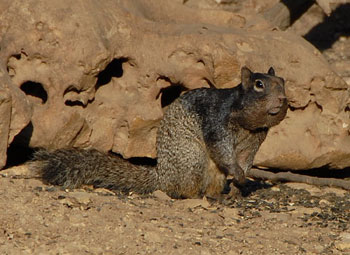Planted new plants from Lady Bird Johnson Wildflower Fall plant sale:
- Blackfoot daisy
- Virginia blueflag
- White yarrow
- Flame leaf sumac
- White salvia
- Cross vine
- Gulf muhly
- Mexican feather grass
Other activities:
- Planted Buffalo grass seed at the edge of road
- Continued removal of KR (king ranch bluestem)
- Removed Johnson grass
- River trail maintenance
Posted in
2006 Journal, Habitat
Rain! Finally, 1 inch or more, a good slow soaking. Birds very active in drizzle after rain.
Planted Buffalo Grass and watersto_jennystone mix around edges of roads near house
Many hummingbirds (20 or more) - Ruby Throated, Black Chinned, Rufous. Continued to feed hummingbirds and keep ant guards full. Yellow jacket wasps visiting hummingbird feeders, but harassing hummingbirds. Put up wasp trap.

Caretaker's note: The cup of water hung above the feeder keeps ants out of the hummingbird food. The water guards also provide another drinking place for thirsty birds in the drought.
The hummingbird feeding mixture is 4 parts water to 1 part plain white sugar. Do not cook to dissolve, just stir very well and keep refrigerated. It is not necessary to add red dye to the feeding mixture because the red color on the feeder will attract the hummingbirds.
Observations:
Caretaker's note: Continued feeding stations. Animals benefit from supplemental feeding, black oil sunflower seeds are a favorite for many species. Using 900 pounds a week
Posted in
2006 Journal, Census, Habitat, Food, Water
- Continued to remove ragweed stems and place on ground on contour on river bottom
- Removed Chinaberry trees at river bottom and used vinegar on stumps
Posted in
2006 Journal, Habitat
Rock Squirrel under porch (new species observed)

- Pulled up dead ragweed stems at river bottom
- Continued waterings
Caretaker's note: Central Texas summers are naturally very hot. This year the long drought added to the extreme heat, causing stress on both plants and animals. Even though watersto_jennystone has full access to the Blanco River, birds and animals benefit from a variety of watering sources scattered throughout the uplands. This water spray is simple and inexpensive. Set the water hose spray nozzle to a wide pattern, point upward and leave on for a few hours in the afternoon to water both plants and birds. Many species of birds frequent the spray, frolicking and bathing.
Posted in
2006 Journal, Census, Habitat
- Saw Nighthawk
- Giant Swallowtail
- Watered all plantings
- Removed Box Elders at river bottom in elderberry patch
Caretaker's note: The Box elders are a native tree common along river bottoms. Like Juniper, however, they can become invasive. By thinning the small trees, there is now more sunlight and room for other species to grow. In this case, we are encouraging elderberries which are an important food source for birds.
Posted in
2006 Journal, Census, Habitat


